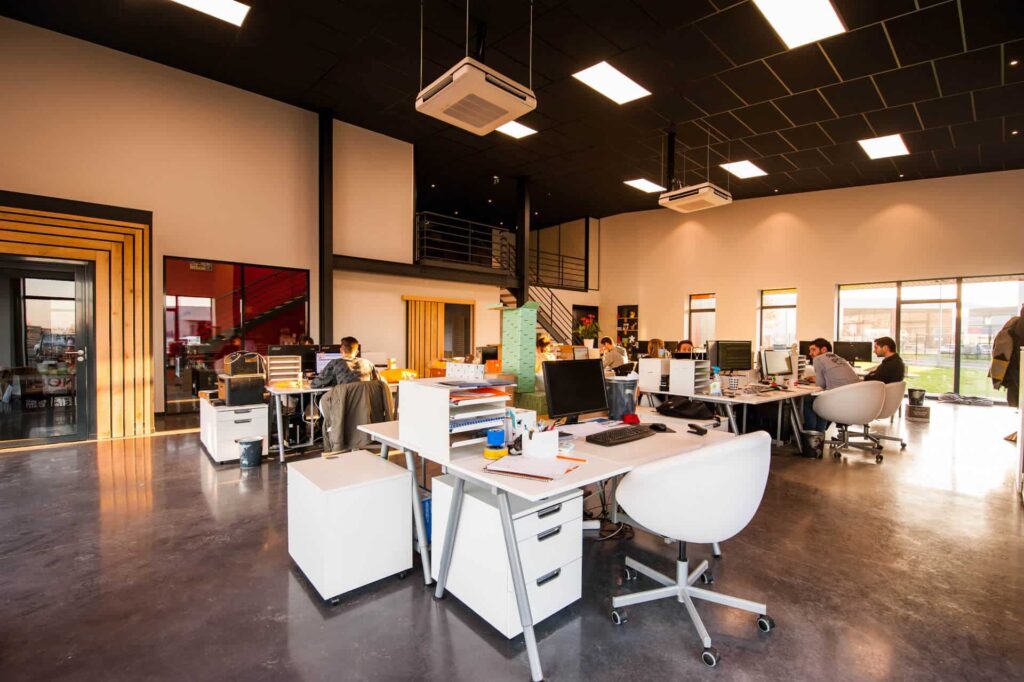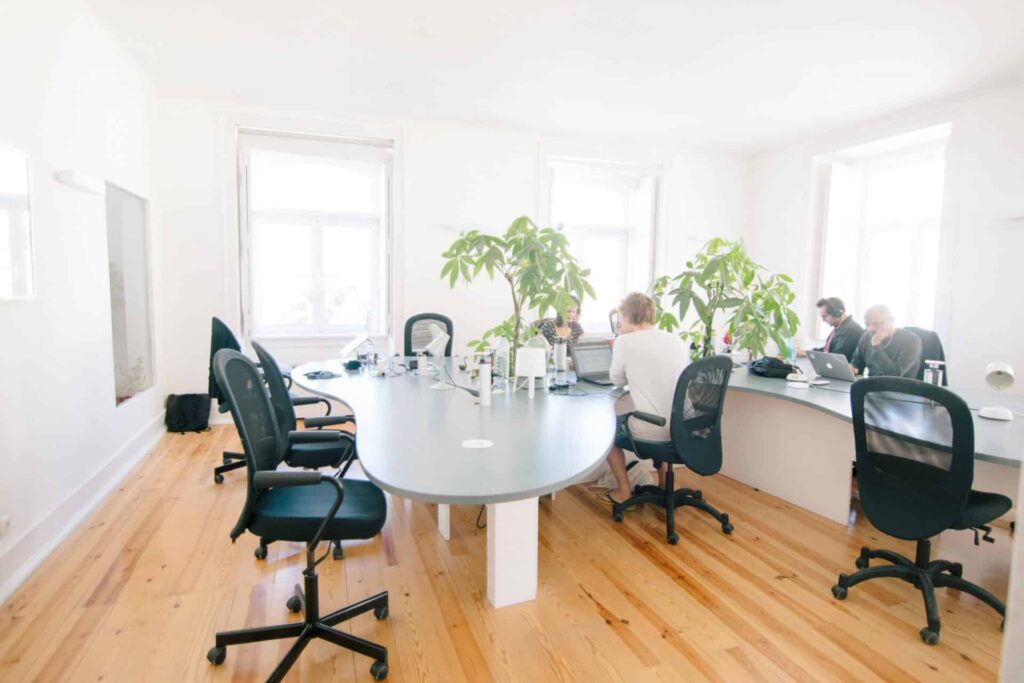Updated- December 11, 2023
Space utilization is a critical part of corporate real estate and facilities management for any organization.
Optimizing how space is being used can future-proof the office. When directors of real estate set space utilization goals, they can improve productivity and employee experience for occupants, in addition to many more benefits.
Below, we’ll explore the ins and outs of space utilization. We’ll also review the tips, technologies, and best practices that can lead to better space utilization.
What is space utilization?
One of the most important metrics in the realm of workspace management, space utilization refers to how effectively a company uses its physical space.
It goes far beyond information like occupancy rate, which is just one benchmark of office space utilization.
It involves tracking and analyzing how different areas within the workspace are used, including offices, meeting rooms, common areas, and workstations. The primary goal of space utilization is to optimize the use of space while enhancing employee productivity, comfort, and overall organizational efficiency.
Effective space utilization strives to create a workspace that aligns with the evolving requirements of the workforce and the business.
This is best handled with space management software capable of tracking the utilization of space through a wide variety of metrics. Workplace Intelligence software can collect space utilization and presence data from workplace sensors, WiFi logins, employee badges, and more to provide dynamic insights about how your sites are being used. Real estate and facilities management teams can then use reports and analytics derived from this data to make better decisions for both staff and employers.
Ultimately, understanding current office space utilization information provides real estate and management teams with insights into the habits that are shaping a workspace and its floor plan. These insights, in turn, can be used to craft a much more efficient office.

How to calculate office space utilization
What rooms are most often in use in your workplace? Knowing this and similar space utilization tracking information can give you insight into habits that are shaping your workplace. This can also help you pinpoint data on where people gather.
Space utilization, in general, can be determined by dividing a building’s occupancy by its capacity.
That said, there’s no specific formula to determine what space utilization strategy will work best for every building or scenario.
In other words, different companies will have different needs and goals. This means they will want to track different metrics to measure how they’re using their space.
Important space utilization metrics
In order to better meet the needs of their particular business, directors of real estate and facilities management teams should choose office utilization software that measures a wide range of data, including these crucial metrics:
- Daily peak utilization: the maximum number of individuals using your space within a single day. This helps identify when your space experiences the highest demand.
- Total square footage: the entire usable space in your facility, including meeting rooms, offices, storage, etc.
- Average peak utilization: the highest space usage periods in a given time frame, including both employees and visitors.
- Total visitor traffic: the total number of individuals who enter and exit your workspace on a given day.
- High-traffic areas: specific zones within your workspace that experience a consistently high flow of people in relation to the rest of your facility.
- Point-in-time occupancy: the total time a given area is occupied, divided by the weekly time that this area is available to users.
- Desk utilization: how frequently individual workstations or desks are occupied.
- Room capacity: the maximum number of people a particular space or room can comfortably accommodate.
- Density: the concentration of people in a particular area of your workspace, which can then be compared to the space allocated for each employee.
- Capacity vs. occupancy: the maximum number of people your space can accommodate vs. the actual number of people present.
- Cost per person: the cost associated with accommodating each person who utilizes your workspace.
- Specific usage areas: designated areas within your workspace meant for particular functions, such as meeting rooms, break areas, or collaboration zones.
Incorporating these space utilization metrics into your workspace management strategy will empower you with the data to make informed decisions that enhance productivity, reduce costs, and create a more comfortable and efficient working environment.
What is data-driven decision-making?
Data-driven decision-making is how smart organizations stay flexible and productive. It’s how they’re able to weather storms like an unexpected global pandemic.
Feelings and hunches about how to improve your office space are great. They can give you a jumping-off point. But until they’re backed up by data, they’re just that—hunches.
Achieving true workplace intelligence requires using data to drive decision-making. Innovative workplace intelligence technologies, AI applications, and machine learning capabilities are constantly improving our ability to collect, analyze, and use data. Tools are becoming increasingly effective and granular in their ability to transform data into actionable strategies.
Dashboards organize and show complex data sets in simple, user-friendly displays, giving you a clear view of performance, from high-level site trends down to individual employee activity. And because they automatically update with the newest data being collected, you can be sure you are using the most current information to make data-driven decisions.
This leads to better outcomes, including cost savings and, ultimately, happier and more engaged team members. When leaders use data to inform their space utilization decisions, they can dramatically improve their workspace.
Why is office space utilization important?
Corporate real estate costs are typically a company’s biggest expense after payroll.
Meanwhile, the average space utilization rate across industries before the pandemic was only 60%, and sometimes lower.
Now that offices have shifted to various hybrid work models and more people are working remotely, an increasing number of desks, conference rooms, and cooperative spaces—i.e., more square feet—may be sitting empty for much of the time.
Following space management best practices to improve the utilization of space can help stop this metaphorical bleeding of wasted real estate.
In addition, efficient space utilization also offers the following six main benefits.
Maximized space use and minimized costs
The most obvious advantage of tracking space usage is the insight into how much space isn’t in use. Companies often overestimate the space occupancy of their facilities.
FMLink reports that one medical facility in southwest England expected staff to increase by 28 percent. Therefore, they thought they needed to expand their space to accommodate the new employees. But after completing a survey, they discovered they were only using about 38% of their current facility. Instead of adding more space—and increasing their real estate budget—they just needed to use their space better.
In this case, tracking space prevented large, costly, and unnecessary changes and moves.
Just as important, when companies understand how their space is used, they can either reduce their overall square footage or repurpose how they are using certain spaces.
In either scenario, the result is usually cost savings along with a better use of space.
Better sustainability
Along with saving on real estate costs, office space utilization can also support sustainability efforts. Using less space is cheaper, of course, and it’s also better for the environment. For companies concerned with the triple bottom line—people, planet, and profit—using their space better is a great way to reduce their carbon footprint in a responsible, sustainable way.
Improved productivity
Another benefit of space tracking is finding the connections between the way people use the space and its effect on productivity.
According to the Wall Street Journal, one Bank of America call center gave employees space utilization sensors that tracked their movements and recorded the tones of their voices when they spoke.
Not surprisingly, they found that workers who bonded with their coworkers and worked together in teams were more productive. To better encourage this relationship-building in the office, the company had workers take breaks in groups instead of individually. This seemingly simple hack to space utilization increased productivity by 10%.
The WSJ also reported that one tech company, using space utilization tracking, concluded that the size of the cafeteria’s lunch tables also affected productivity. Workers who sat at the 12-person table were more productive than their peers who sat at 4-seaters.
What this means is that improving space utilization rate can also improve overall productivity.
Better employee experience
As the Bank of America example shows, when real estate directors know how employees are using the office, they can better design it to meet their needs and preferences.
Moreover, we know that all generations in the workplace are clamoring for more flexibility. A new survey by LinkedIn suggests it’s the highest priority for most workers.
As we’ll cover below, efficient utilization of space also supports flexible working, further enhancing employee well-being and the workplace experience.
Design an efficient workplace with Space Planning. Optimize office layouts and maximize space utilization.

Better flexible working
It’s now universally agreed that for most industries, the post-pandemic office will remain flexible and/or hybrid in some capacity.
Of course, while the hybrid office looks great on paper, implementing it presents a bigger challenge to both today’s FM and corporate real estate management teams.
That means space utilization and management, as part of a robust Integrated Workplace Management System (IWMS) system that includes Workplace Intelligence capabilities, is critical to supporting a range of flexible working practices and work environment types. When managers have data-driven insights into how people are using the space, they can provide better visibility and guidance to the occupants on how and when they should be coming to the office. This, in turn, can improve both agile working and other flexible working models.
A future-proofed office
Ultimately, space utilization is at the heart of how companies can optimize the workplace. Measuring space utilization is an important part of gaining the knowledge to make informed decisions.
When leadership teams have access to real-time data and user-friendly analytics, they can better forecast, track, and measure how people are using the space. This can help them create better workflows, reduce space costs, and provide better move management, benefiting employees and employers alike.

Space utilization challenges
Space utilization planning can pose a number of unique challenges. Every business is unique, and office space utilization should work with your existing culture and workflow rather than against it. To do this effectively, it’s important to consider some of the workplace factors that can affect how space utilization is implemented.
Type of work being done
Different types of work require different types of spaces. For instance, more collaborative work may thrive in community areas, larger meeting rooms, or open desk arrangements, while individual-focused work may require private offices or quiet spaces.
Consider whether your work involves tasks that require specialized equipment or other specific or unique spaces. Flexibility in space allocation is essential to accommodate various work functions efficiently.
Company culture
Companies that prioritize collaboration may need more open and communal spaces. A culture that values flexibility and remote work may require fewer dedicated workstations. Businesses that value innovation might benefit from dedicated creative spaces or brainstorming rooms.
How you use your space is reflected in your company culture, which influences how you optimize your space.

Office layout
The physical layout and design of your workspace may also play a significant role in space utilization. An open floor plan can encourage collaboration, while a more traditional layout might suit a structured and hierarchical organization.
Availability of technology
The availability of remote work technology can impact the need for on-site workstations and availability. Companies with robust remote work capabilities may require less space, while businesses made up of employees with limited remote work resources may need more versatile accommodations.
Combining data sets
An effective space utilization strategy not only requires collecting data from a variety of sources, it also necessitates the ability to analyze and synthesize that information together into one cohesive picture. Combining desk and conference room reservations, badge swipes, check-ins, wifi logins, and sensor data together manually takes a tremendous amount of time and effort. And because this data is constantly being accumulated and may change over time, organizations run the risk of using outdated or unreliable information to formulate strategies that address their space utilization needs.
That’s where workplace intelligence tools come in. Using advanced and dynamic software like OfficeSpace allows you to instantly combine and analyze your collected data to provide an accurate assessment of your needs. This allows teams and executives to adapt to changes in real time and ensure decisions are backed by the most up-to-date information available.

Best practices for space utilization in the office
It’s only possible to properly track and improve space utilization when there is capable software and reliable data. With the right information, it is possible to make continual and insightful adjustments to space utilization.
Beyond this, there are several best practices to follow to ensure the most efficient office space utilization for any organization.
First, companies may want to consider using occupancy sensors, which can make flexible room booking and desk booking much simpler.
While not absolutely necessary, IoT sensors can provide a more in-depth picture of how employees are actually using the office, as the Bank of America example above illustrates.
Second, adopting flexible working models like activity-based working, office neighborhoods, hot desking, and agile working are all proven ways for employees to use shared office space more effectively.
Finally, one of the keys to success is to communicate the reason and expectations for any changes to staff clearly and directly. To do this successfully, it often makes sense for real estate directors to recommend that FM managers collaborate with their HR counterparts to ease any internal concerns employees may have about their movements being tracked.
Addressing space utilization concerns
No discussion of space tracking is complete without addressing potential employee concerns, especially with regard to tools like badges or sensors. If the topic of space tracking isn’t presented carefully, employees may feel like they’re being spied on or micromanaged. This may cause them to change their behaviors, meaning you won’t be collecting data about how they normally use their space.
It’s crucial to speak with employees about how these devices work and ensure they understand what kind of information is being collected. However, once they understand the potential cost savings associated with better office space utilization, it’s often a no-brainer.
OfficeSpace works hand-in-hand with FMs to improve space utilization. Schedule a free demo today!
Photos: fauxels, Cadeau Maestro, Tima Miroshnichenko, Croissant, Christina Morillo, Karolina Grabowska





